| |||||||||||||
| |||||||||||||
|
|||
Introduction"Le Bourgeois Gentilhomme" by Jean-Baptiste Poquelin (15 Jan. 1622 - 17 Feb. 1673) — better known by his stage name Molière — is a five-act comédie-ballet(1) about a social-climbing middle-class merchant in the mid-to-late seventeenth century. Monsieur Jourdain, seen in his opulent Paris residence, aspires to join the aristocracy by ordering splendid new clothes, engaging in such aristocratic pastimes as fencing and dancing, and learning the language of the noble class. 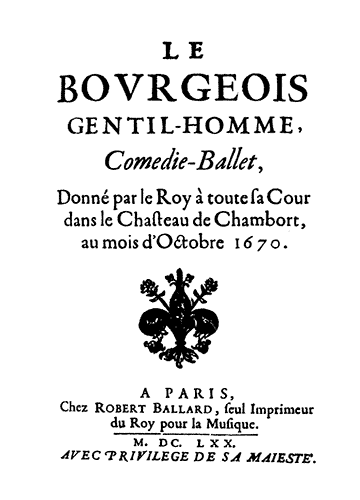
Original program cover for the production of 'Le Bourgeois Gentilhomme' staged by Molière's acting troupe at Château de Chambord in October 1670. (click on image to enlarge) In the process, he manages to make a complete fool of himself, much to the dismay of his intelligent wife. At the end, he is hoodwinked into believing that his daughter Lucile will marry into Turkish royalty, in an elaborate and ridiculous ceremony staged by the daughter's middle-class suitor in cahoots with M. Jourdain's valet and Madame Jourdain. BackgroundMolière's work is an example of neoclassical comedy, a genre in which "contemporary society became one of the central concerns of the comic dramatist."(2) Molière was a master in this genre, as he was thoroughly familiar with French society of the time, and had been trained in the theatre long before becoming a playwright. Contemporary writings reported that King Louis XIV commissioned the play in 1670 on short notice, to be performed during his fall hunting sojourn in the Loire Valley. Louis had felt insulted during a visit by Suleiman Aga(3), an envoy of the Ottoman Empire, who boasted of the magnificence of the Turkish court compared to that of France. The King therefore requested that certain plot elements be incorporated into Molière's production, in particular to lampoon Turkish ceremonies.(4) 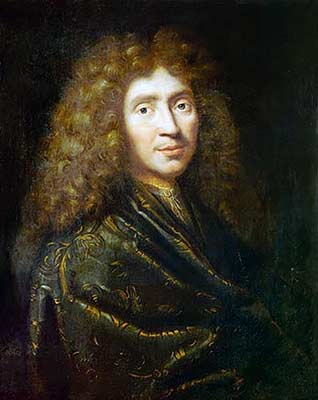
Portrait of Jean-Baptiste Poquelin, a.k.a. Molière – French actor, director, playwright. (click on image to enlarge) Though the date it was written is unclear, the play was first presented at Château de Chambord (department of Loir-et-Cher, France) on 14 October 1670, before moving to the Théâtre du Palais-Royal in Paris on 23 November 1670. Modern performances are produced at La Comédie-Française(5) in the Salle Richelieu (part of the Palais-Royal complex), and at the Théâtre des Bouffes du Nord(6), as well as dozens of venues throughout France and worldwide. The production's musical score, consisting of eleven pieces, was written by the Italian-born French composer Jean-Baptiste Lully (a.k.a. Giovanni Battista Lulli; 28 Nov. 1632 - 22 Mar. 1687), who served much of his life as court composer for Louis XIV. Lully has been acknowledged as a master of French baroque music. Choreography was arranged by Pierre Beauchamp (a.k.a. Charles-Louis Beauchamp; 30 Oct. 1631 - Feb. 1705), who worked for Molière's acting company (the Troupe du Roy) from 1664 to 1673. Beauchamp débuted at the court of King Louis XIV in 1648, at age 12. He later became ballet master at the Académie Royale de Musique, and in 1671 was appointed director of the Académie Royale de Danse. The English playwright Edward Ravenscroft imitated (one might say pilfered, or plagiarized) Molière's work by publishing a play called "Mamamouchi; or the Citizen turned Gentleman" in 1671 (Dorset Garden), a year after Le Bourgeois Gentilhomme's release in France.(7,8) 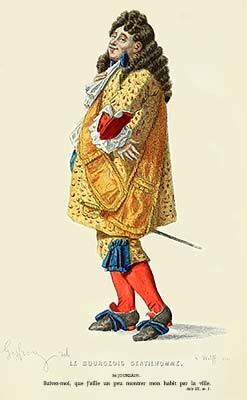
Color etching of the lead character M. Jourdain dressed in gaudy court clothing, complete with wig and sword. (click on image to enlarge) The play's title is meant to be an oxymoron. In Molière's time, a gentleman was understood to be from the noble class ("a man of gentle birth"(9)), thus there could be no such thing as a 'bourgeois gentleman'. In its original performance, Molière played the lead role of M. Jourdain, while his real-life wife (Armande Béjart, 21 years his junior) played the role of Lucile, M. Jourdain's daughter. The play's musical composer, Jean-Baptiste Lully, "personally undertook the role of the Mufti in the Turkish ceremony."(9) StorylineThe play's entire story takes place in 17th-century Paris, France, in the Jourdain residence. During an overture of several minutes by the pit orchestra, the curtain opens (point of attack) to reveal the Music Master's pupil, alone at a desk, in the process of composing a score. As the overture draws to a close, one instrument continues playing as the pupil begins to sing. A few moments later, he is joined by the Music Master, Dancing Master, and several dancers. After the Music Master reviews his score approvingly, the pupil exits. 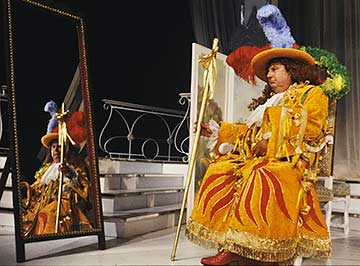
M. Jourdain admires himself in the mirror, during a 1981 production by the itinerant theatrical troupe Tréteaux de France, at Meudon. (click on image to enlarge) The first scene functions as an exposition, in which the audience learns what the instructors feel about Monsieur Jourdain. The Music Master is grateful to have Jourdain as a student because he pays well, while the Dancing Master feels that Jourdain is incapable of truly appreciating his work. While they discuss their relationship with Jourdain and his lack of taste, it becomes clear that the instructors themselves are charlatans whose very jobs depend on Jourdain's sheer ignorance. Enter Monsieur Jourdain dressed in a gaudy striped dressing gown and nightcap, followed by two of his lackeys. He asks the Masters to show him their "little trifle", a performance of song and dance, while he awaits the delivery of a fancy new outfit from his tailor. Through the first two acts, we witness M. Jourdain taking lessons from a variety of tutors, each of whom must dumb down their instruction to match Jourdain's total ignorance. Yet, with each new "revelation" of knowledge, trivial though it may be, Jourdain expresses unbridled amazement at the wonderful things he's learned, and hastens to show off his new-found expertise to Mme Jourdain and Nicole, their maid. 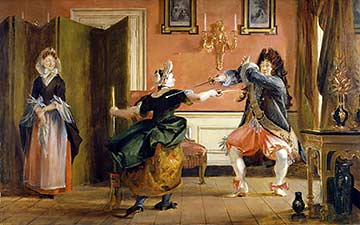
In demonstrating his new fencing 'skills' to his maidservant Nicole, M. Jourdain is embarrassed to be struck several times by her foil. His wife looks on in amusement. (click on image to enlarge) MONSIEUR JOURDAIN: Goodness! I have been speaking prose for over forty years without being aware of it, and I am much obliged to you for having taught me that.(10a) Meanwhile, M. Jourdain's daughter Lucile is in love with Cléonte, a respectable and honest young man, whom she hopes to marry. Her father interviews Cléonte and asks him if he's a gentleman. Aware that it would be dishonest to claim such social status, Cléonte admits he is not. When M. Jourdain insists that his daughter must only marry into a noble family, his wife protests: MADAME JOURDAIN: As for me, it's something to which I'll never agree. Marriages above one's station always run into problems. I have absolutely no wish for a son-in-law who will quarrel with my daughter because of her parents' station in life, and I don't want her to have children who will be ashamed to call me their grandmother.(10b) 
Covielle, Cléonte's lackey, devises a plan to circumvent M. Jourdain's stubborn pride. He shows up at the Jourdain house disguised as an old man dressed in oriental costume. He manages to convince Jourdain that he was a good friend of his father's, and that he has recently returned from extended world travels. To Jourdain's great astonishment and delight, Covielle claims that M. Jourdain's father was a gentleman rather than a bourgeois merchant — implying that Jourdain was born a gentleman as well. The pretense is patently false, of course, but Jourdain is gullible and believes the fabrication. After telling Jourdain that a Turkish Sultan is visiting Paris, Covielle persuades Jourdain that the Sultan's son wishes to marry Lucile, and that Jourdain himself stands to be honored with the title of Mamamouchi — a position of high rank comparable to that of a paladin. To embellish his story, Covielle pretends to teach Jourdain some purportedly Arabian phrases, which are in fact pure gibberish. COVIELLE: The son of the Turkish Sultan, your son-in-law. As I went to see him, and as I understand his language perfectly, he spoke with me; and, after some other talk, he said to me, "Acciam croc soler ouch alla moustaph gidelum amanahem varahini oussere carbulath," that is to say, "Haven't you seen a beautiful young person who is the daughter of Monsieur Jourdain, a Parisian gentleman?"(10c) 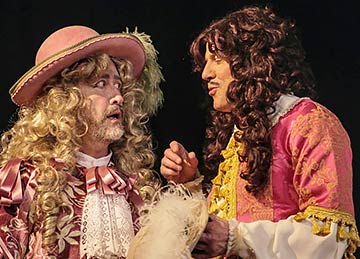
The economically challenged Count Dorante flatters M. Jourdain in order to fleece him out of his money. Production at La Manoque (theatre), Tonneins, France. (click on image to enlarge) Covielle expands on his "lesson" to say that "marababa sahem" means "Ah, how I love her!"; and that "Cacaracamouchen" means "My dear heart". M. Jourdain's reaction is to exclaim, "What a wonderful language Turkish is!" When Covielle explains that the Sultan's son will be arriving shortly to perform the ceremony, Jourdain counters by saying that "my daughter is a stubborn girl who has got into her head a certain Cléonte, and she swears she'll marry no one but him." Covielle reassures Jourdain that — quite coincidentally — the Sultan's son looks just like Cléonte, and that "the love she has for one of them can easily be transferred to the other."(10d) During a lavish and ridiculous ceremony concocted by Mme Jourdain, Covielle, and Cléonte, M. Jourdain is tricked into believing that his daughter is marrying into Turkish royalty and that he has been the recipient of the noble title Mamamouchi. In fact, it is Cléonte who is disguised as the Sultan's son. While the charade is ultimately revealed and M. Jourdain is painfully reminded of his true station in life, la bourgeoisie does manage to have the last laugh — about a century later (thus unbeknownst to Molière or his troupe) — when the French Revolution topples the class system permanently. ConclusionMolière's play is a satire of France's class system in the 17th century. When France was a monarchy, the aristocracy (or nobility) were known as the Second Estate; middle- and working-class citizens comprised the Third Estate, which had little social prestige and no political power. (The King, an absolute monarch quite dissimilar to modern European monarchies like the U.K., was the First Estate.) While wealthy middle-class merchants could enjoy a relatively comfortable existence, it was not possible to break the "glass ceiling" into the ranks of nobility, the latter being a hereditary class. The play's protagonist, Monsieur Jourdain, is a well-to-do cloth merchant intent on changing the status quo and becoming a 'noble' in his own right — "the original culture vulture", according to reviewer Elisabeth Vincentelli of the New York Times.(11) He thinks he can do so by donning the accoutrements of nobility — ostentatious clothing, powdered wigs, platform shoes, and the like. He also engages the services of tutors to learn the refinements of nobility — including polite language, dancing, fencing … — but his antics only make him a buffoon and a laughing stock to his embarassed relatives. After Louis and his court had watched the entertainment of the play at its first unveiling, the King kept Molière hanging in suspense for several days without a word about his reaction to the piece. Finally, Louis did express his extreme pleasure with the production — to Molière's great relief and satisfaction. Footnotes(1) comédie-ballet: a hybrid theatrical genre established by Molière and Lully, which combines a spoken play with sung and danced interludes (fr. intermèdes) and act closings. (3) Suleiman Aga, a.k.a. Soleiman Agha in France, reportedly "refused to bow to Louis XIV, who immediately banished him to Paris, away from Versailles." (Bernstein) (5) La Comédie-Française was established at Théâtre de l'Odéon in 1689. From 1770 to 1782, it was housed at the royal palace of the Tuileries (destroyed during the Paris Commune in 1871). Since 1799, the troupe has performed at its present location in the Salle Richelieu at the Palais-Royal. Modified and enlarged in the 1800s, it was rebuilt in 1900 after a severe fire. (6) The Bouffes du Nord is a theater at 37 bis, boulevard de la Chapelle in the 10th arrondissement of Paris, located near the Gare du Nord. First opened in 1876, it has been listed since 1993 as a monument historique by the French Ministry of Culture. Artistic directors are Olivier Mantéi and Olivier Poubelle. Author, editor: Ian C. Mills © 2018- – All Rights Reserved. Sources:
Applebaum, Stanley. "Tartuffe and The Bourgeois Gentleman, A Dual-Language Book", 1998. (1)(4)(9) Introduction, pp. x-xi, (10) (a) pg. 231, (b) pg. 307, (c) pg. 339, (d) pg. 343. Dover Publications, Inc., Mineola, New York. ISBN 9780486404387. Relevant publications: [coming soon] Images: "Website header for the production of Le Bourgeois Gentilhomme by Compagnie Michel B. at Théâtre Espace Marais, Paris", artist unknown, from Compagnie Michel B. "Original program cover for the production of Le Bourgeois Gentilhomme staged by Molière's acting troupe at Château de Chambord in October 1670", by Robert Ballard, printer for the King (Louis XIV) of France, from Bibliothèque nationale de France. "Portrait of Jean-Baptiste Poquelin (nom de plume, Molière) – French actor, director, playwright", artist unknown, from Pinterest. "Château de Chambord and its reflection at dusk", photographer: Émilie Merlet, from Lycée de l'Abbaye. "A color etching of the lead character M. Jourdain dressed in full royal court clothing, complete with wig and sword, from the play Le Bourgeois Gentilhomme by Molière", artist: L. Wolff, from Informations et documents. "M. Jourdain admires himself in the mirror, during a 1981 production by Tréteaux de France", photographer: Daniel Cande (1981), mise-en-scène by Jean-Louis Martin-Barbaz, from Bibliothèque nationale de France. "Mme Jourdain is amused as Nicole embarasses her husband in fencing, striking a blow (touche)", artist: Charles Robert Leslie, ca. 1841 (painted; oil on canvas), from théâtre-documentation.com (black & white) and Victoria and Albert Museum (V&A), Cromwell Road, London SW7 2RL – The Edwin and Susan Davies Galleries, location: Room 82, case East Wall (color). "The old Comédie-Française logo, before its modernization in 2015", artist unknown, from Wikimedia Commons. "The Count Dorante flatters M. Jourdain in order to fleece him out of his money", photographer unknown, from Sortir47, a French entertainment e-zine for department 47 (Lot-et-Garonne, province of Aquitaine). — All Rights Reserved. Related videosFirst video: Le Bourgeois Gentilhomme. A full-length performance of the 1670 French version, including all musical and dance interludes (fr. intermèdes), produced in Nov. 2004 by Arte France for French television; directed by Martin Fraudreau. (3:30:25)
Videos: (replay) |
Bales Theater |
Warren Township |
UCSC Playhouse
Short link to this page: https://goo.gl/qREUhr
|
||||||||||